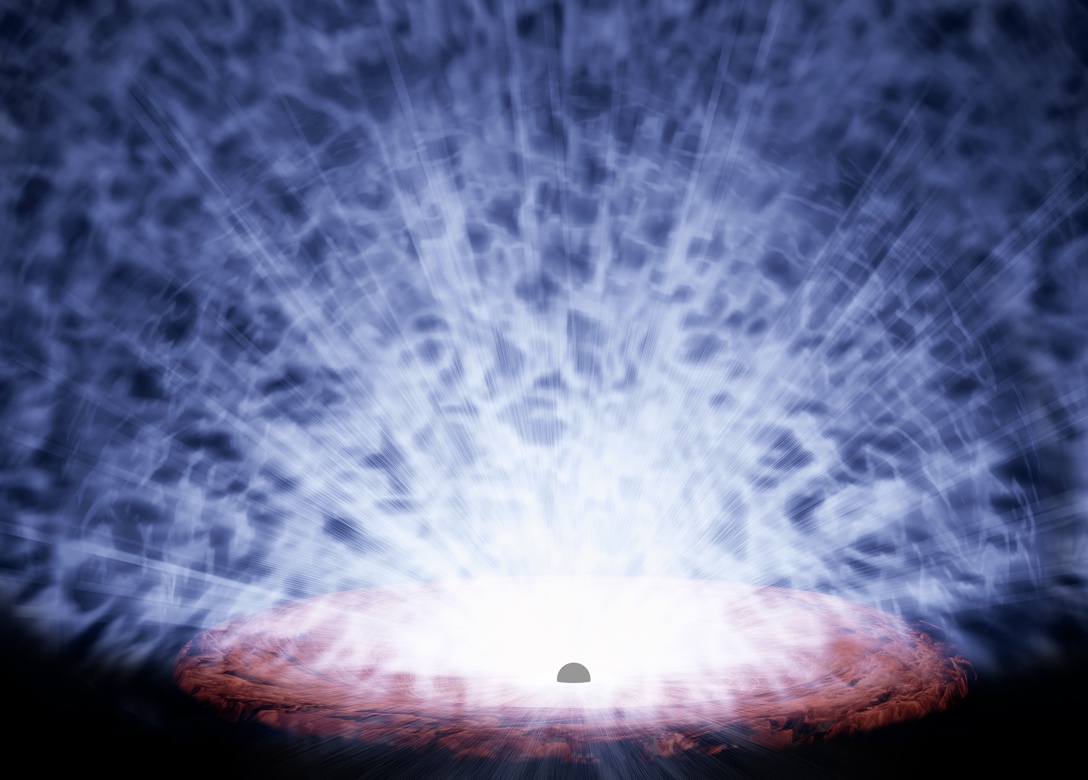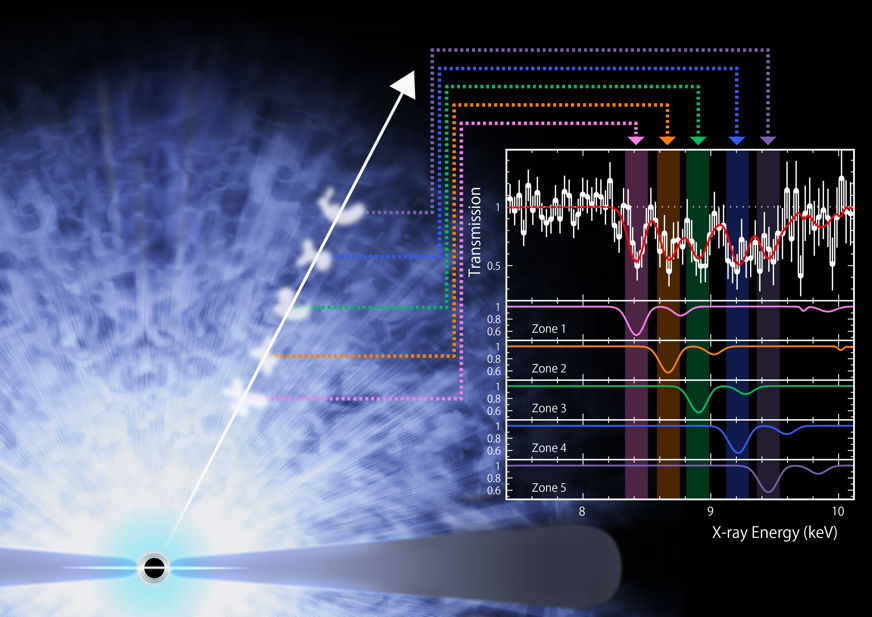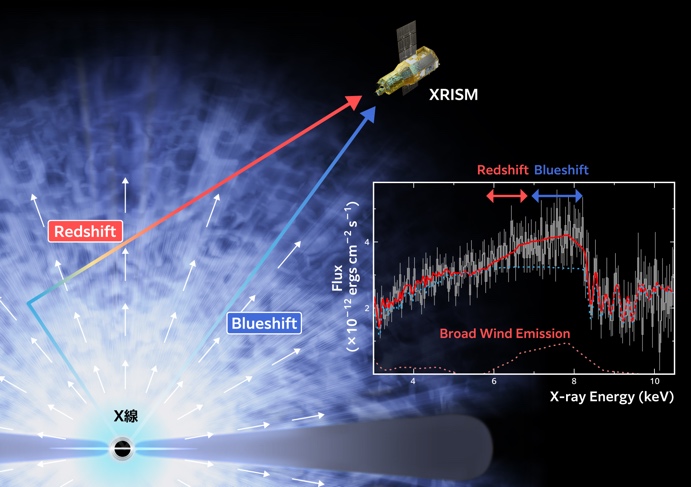X-Ray Imaging and Spectroscopy Mission (XRISM) Unveils Super High-Speed Bullet-Like Winds Shooting from a Supermassive Black Hole (Nature publication)
May 15, 2025 (JST)
Japan Aerospace Exploration Agency
The Japan Aerospace Exploration Agency (JAXA) announces that a paper presenting the results of research based on X-Ray Imaging and Spectroscopy Mission (XRISM) was published in the UK scientific journal “Nature” on May 15, 2025 (JST).
Title:
Structured ionized winds shooting out from a quasar at relativistic speeds
Journal:
Nature
DOI:
10.1038/s41586-025-08968-2External Link
Structured ionized winds shooting out from a quasar at relativistic speeds
1. Key Points
•
Using the powerful spectroscopic capabilities of the X-ray Imaging and Spectroscopy Mission (XRISM), ultra-fast winds from a supermassive black hole have been discovered for the first time to possess an unexpectedly complex velocity structure.
•
This structure indicates that the wind is not smooth and continuous as previously assumed, but instead consists of bullet-like clumps, as illustrated in Figure 1.
•
The energy carried by these gas bullets is far greater than anticipated, offering new insights into how galaxies and their central black holes evolve together.

© JAXA
Figure 1:
Artist’s impression of the supermassive black hole PDS 456. High-speed winds—illustrated in white—are being ejected from the vicinity of the black hole.
2. Abstract
Supermassive black holes lie at the centers of all galaxies and are believed to evolve along with their host galaxies–a process known as “galaxy–black hole coevolution.” Understanding this intricate relationship remains one of the most compelling challenges in astrophysics. A central player in this process is the “wind” or “outflow” of gas that black holes eject at high speeds. These outflows are thought to regulate star formation by heating or expelling the surrounding gas, thereby shaping the growth of both the galaxy and the black hole.
To truly understand the impact of the wind, astronomers must precisely measure the motion and energy of the outflowing gas. However, until now, existing instruments lacked the resolution and sensitivity to uncover the finer details.
In this study, an international team of researchers (the XRISM Collaboration, hereinafter referred to as the “research team”) observed winds traveling at 20–30% of the speed of light from a supermassive black hole. These observations were performed with the X-ray Imaging and Spectroscopy Mission (XRISM), a JAXA-led international space telescope to perform high resolution observations of X-rays emitted by very hot gas. For the first time, the research team revealed that these winds are not smooth but made up of at least five distinct gas components, each moving at different velocities. This indicates a complicated clumpy wind structure resembling a rapid-fire stream of gas “bullets.” Such a breakthrough was only possible thanks to XRISM’s exceptional capabilities in resolving the velocity structure of the winds.
By accounting for this bullet-like structure, the research team estimated that the black hole expels gas at a rate of 60 to 300 solar masses per year. The energy carried by these winds is over 1,000 times greater than that of galactic-scale winds*1, dramatically altering our understanding of their role.
These findings suggest that gas is being intermittently ejected like a geyser or channeled through gaps in the surrounding interstellar medium, challenging long-standing theories of galaxy–black hole coevolution. Continued observations with XRISM promise to deepen our understanding of how these powerful winds influence the “galaxy-black hole coevolution”.
3. Main Text
Background
It is widely believed that every galaxy harbors a supermassive black hole at its center—objects with masses millions of times that of the Sun. Over cosmic time, these black holes and their host galaxies are thought to have evolved together in a tightly linked process. Yet, because of the vast difference in their size and mass, the exact mechanisms behind this interaction remain unclear, making the “coevolution of galaxies and black holes” one of the most profound mysteries in modern astrophysics.
A crucial clue in solving this puzzle lies in the powerful gas flows—known as “outflows” or “winds”—that are expelled from the regions around black holes at extremely high speeds. These winds are believed to influence coevolution in two major ways: by regulating the growth of black holes through feedback that limits the inflow of matter, and by injecting vast amounts of energy into their host galaxies, potentially shutting down star formation.
However, the impact of these winds depends heavily on the amount of energy they carry. To estimate this energy accurately, researchers must first determine the wind’s structure and shape of the wind in detail—something that has remained beyond the reach of conventional observation techniques.
Observation Results
In March 2024, the research team observed the supermassive black hole PDS 456, located about 2 billion light-years from Earth, using the X-Ray Imaging and Spectroscopy Mission (XRISM). With XRISM’s onboard soft X-ray spectrometer Resolve, they obtained high-resolution X-ray spectra, revealing—for the first time—complex absorption line *2 structures (Figure 2). Previously, these features had appeared as a single, broad absorption line. Thanks to Resolve’s exceptional spectral precision, the intricate internal structure is now observable.

© JAXA
Figure 2:
Absorption line spectrum of PDS 456 captured by XRISM's soft X-ray spectrometer, Resolve. In the top graph, the white lines and dots show the observed data, while the red lines represent the spectral model. The five panels below illustrate how gas moving at different velocities appears as absorption lines at varying energies due to the Doppler effect. These complex absorption features are caused by at least five distinct, bullet-like winds. The strongest absorption lines in each panel correspond to helium-like iron ions (iron atoms with only two electrons).
A detailed analysis of these absorption lines revealed at least five distinct components of gas within the black hole’s outflow, each traveling at 20–30% the speed of light (roughly 200 to 300 million km/h). These findings suggest that the wind is not smooth, as previously assumed, but has a clumpy, bullet-like structure, with many discrete high-velocity components.
In addition to the absorption features, XRISM also successfully detected emission lines*3 (Figure 3) originating from the wind. These X-rays are emitted by gas moving both toward and away from Earth. Due to the Doppler effect*4, this motion broadens the emission lines. Moreover, the strength of the emission lines reflects the total gas content in the wind. The observed line intensities indicate that the outflow is expanding nearly isotropically—in all directions.

© JAXA
Figure 3:
X-ray emission line spectrum of PDS 456 observed with Resolve. The white curve shows the observed data, while the red curve represents the best-fit model. The blue dashed line indicates the component where X-rays pass through the wind (absorption), and the pink dashed line represents the emission from the wind itself; together, they form the total model (red curve). In the absence of gas motion, emission lines from helium-like and hydrogen-like iron (iron ions with two and one electrons, respectively) would appear at 6.7 keV and 6.97 keV. However, the emission from gas approaching Earth (blue-shifted) and gas moving away (red-shifted) blends together, creating a broadened emission feature (pink dashed line). The intensity and broadening of the line suggest that the wind is expanding in nearly all directions.
Based on this newly revealed picture of a “bullet-like wind” radiating in all directions, the research team estimated the total amount of gas and energy carried by the outflow. Their analysis revealed that this structured wind carries far more energy than previous models predicted—expelling gas at a rate equivalent to 60 to 300 times the mass of the Sun each year. Remarkably, this powerful wind, originating just 0.1 light-years from the black hole, contains over 1,000 times more energy than galactic-scale winds that span thousands of light-years.
This groundbreaking discovery challenges existing theoretical models of galaxy–black hole coevolution. Until now, models assumed that the energy and momentum from winds launched near black holes were smoothly transferred to larger-scale galactic winds, regulating star formation and galactic growth [References: 1–3]. However, the new results suggest otherwise: much of the wind’s energy is not transferred outward but instead may be released in bursts—like geysers—or escape through gaps in surrounding interstellar gas. These findings highlight the need for a new theoretical framework to explain galaxy–black hole coevolution under such complex conditions.
Prospects
Looking ahead, XRISM will enable detailed studies of wind structures not only in PDS 456—the target of this study—but also in a broader range of black holes. By expanding these observations, the research team aims to uncover how such winds influence the coevolution of black holes and their host galaxies. Gaining deeper insight into this process is essential for understanding the formation, structure, and long-term evolution of the Universe itself.
About the XRISM Project
XRISM (X-ray Imaging and Spectroscopy Mission) is an international X-ray space observatory project led by JAXA in collaboration with the National Aeronautics and Space Administration (NASA), with contributions from the European Space Agency (ESA). The mission also involves numerous universities and research institutions both in Japan and abroad, making it a truly global scientific effort.
Resolve is an X-ray microcalorimeter spectrometer capable of high-resolution spectroscopy, developed through collaboration between Japan, the United States, and European partners.
4. Glossary
*1 Galactic-scale wind:Outflows observed in radio and infrared wavelengths that span entire galaxies—thousands of light-years across. In contrast, X-ray winds like those in PDS 456 originate much closer to the black hole (within 0.1 light-years). Earlier theories proposed that galactic-scale winds are powered by energy transferred from these inner winds.
*2 Absorption line : A dip in a continuous spectrum, where intensity decreases at a specific energy. In X-rays, this occurs when electrons bound to atoms absorb incoming photons, moving to higher energy levels. These lines are specific to each element and ionization state. In this study, X-rays from the vicinity of the black hole were absorbed by outflowing gas, creating the absorption features shown in Figure 2.
*3 Emission line: A peak in a spectrum at a specific energy, created when electrons drop to lower energy levels and emit photons. Each emission line corresponds to a unique atomic transition. In this observation, emission lines were produced by wind gas illuminated by intense X-rays near the black hole.
*4 Doppler effect: Just like the Doppler effect you hear with sound—where a siren sounds higher in pitch as it comes toward you and lower as it moves away—the same effect happens with light, including X-rays. When something is moving toward us, the light it gives off shifts to higher energy (or higher frequency). When it’s moving away, the light shifts to lower energy. In visible light, lower energy appears red and higher energy appears blue. So, light from objects moving toward us is “blueshifted,” and light from objects moving away is “redshifted.”
5. References
[1] Mizumoto et al., 2019, ApJ
[2] Tombesi et al., 2015, Nature
[3] King & Pounds, 2015, ARAA